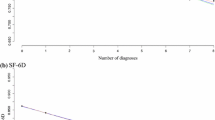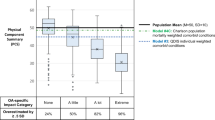Abstract
Purpose
To refine two subscales of the health-related quality of life comorbidity index (HRQoL-CI) into a single index measure.
Methods
The 2010 and 2012 Medical Expenditure Panel Surveys were utilized as development and validation datasets, respectively. The least absolute shrinkage and selection operator was applied to select important comorbidity candidates associated with HRQoL. Exploratory factor analysis and confirmatory factor analysis (CFA) were used to assess dimensionality in comorbidity. Statistical weights were derived based on standardized factor loadings from CFA and regression coefficients from the model predicting HRQoL. Prediction errors and model R2 values were compared between HRQoL-CI and Charlson CI (CCI).
Results
Eighteen comorbid conditions were identified. CFA models indicated that the second-order multidimensional comorbidity structure had a better fit to the data than did the first-order unidimensional structure. The predictive performance of the refined scale under a multidimensional structure utilizing statistical weights outperformed the original scale and CCI in terms of average prediction error and R2 in the prediction models (R2 values from refined scale model are 0.25, 0.30, and 0.28 versus those from CCI of 0.10, 0.09, and 0.06 for general health, SF-6D, and EQ-5D, respectively).
Conclusion
The dimensionality of comorbidity and the weight scheme significantly improved the performance of the refined HRQoL-CI. The refined single HRQoL-CI measure appears to be an appropriate and valid instrument specific for risk adjustment in studies of HRQoL. Future research that validates the refined scales for different cultures, age groups, and healthcare settings is warranted.


Similar content being viewed by others
References
Wu, S. Y., & Green, A. (2000). Projection of chronic illness prevalence and cost inflation. Washington, DC: RAND Health.
van den Akker, M., Buntinx, F., Metsemakers, J. F., Roos, S., & Knottnerus, J. A. (1998). Multimorbidity in general practice: Prevalence, incidence, and determinants of co-occurring chronic and recurrent diseases. Journal of Clinical Epidemiology, 51(5), 367–375.
Knottnerus, J. A., Metsemakers, J., Hoppener, P., & Limonard, C. (1992). Chronic illness in the community and the concept of ‘social prevalence’. Family Practice, 9(1), 15–21.
Schellevis, F. G., van der Velden, J., van de Lisdonk, E., van Eijk, J. T., & van Weel, C. (1993). Comorbidity of chronic diseases in general practice. Journal of Clinical Epidemiology, 46(5), 469–473.
Metsemakers, J. F., Hoppener, P., Knottnerus, J. A., Kocken, R. J., & Limonard, C. B. (1992). Computerized health information in The Netherlands: A registration network of family practices. British Journal of General Practice, 42(356), 102–106.
Wolff, J. L., Starfield, B., & Anderson, G. (2002). Prevalence, expenditures, and complications of multiple chronic conditions in the elderly. Archives of Internal Medicine, 162(20), 2269–2276.
Jones, C. A., Voaklander, D. C., Johnston, D. W., & Suarez-Almazor, M. E. (2000). Health related quality of life outcomes after total hip and knee arthroplasties in a community based population. The Journal of rheumatology, 27(7), 1745–1752.
Jones, C. A., Voaklander, D. C., Johnston, D. W., & Suarez-Almazor, M. E. (2001). The effect of age on pain, function, and quality of life after total hip and knee arthroplasty. Archives of Internal Medicine, 161(3), 454–460.
Smith, A. W., Reeve, B. B., Bellizzi, K. M., Harlan, L. C., Klabunde, C. N., Amsellem, M., et al. (2008). Cancer, comorbidities, and health-related quality of life of older adults. Health Care Financ Rev, 29(4), 41–56.
Hays, R. D., Cunningham, W. E., Sherbourne, C. D., Wilson, I. B., Wu, A. W., Cleary, P. D., et al. (2000). Health-related quality of life in patients with human immunodeficiency virus infection in the United States: Results from the HIV Cost and Services Utilization Study. American Journal of Medicine, 108(9), 714–722.
Richardson, L. C., Wingo, P. A., Zack, M. M., Zahran, H. S., & King, J. B. (2008). Health-related quality of life in cancer survivors between ages 20 and 64 years: Population-based estimates from the Behavioral Risk Factor Surveillance System. Cancer, 112(6), 1380–1389.
Vogeli, C., Shields, A. E., Lee, T. A., Gibson, T. B., Marder, W. D., Weiss, K. B., et al. (2007). Multiple chronic conditions: Prevalence, health consequences, and implications for quality, care management, and costs. Journal of General Internal Medicine, 22(Suppl 3), 391–395.
Lash, T. L., Mor, V., Wieland, D., Ferrucci, L., Satariano, W., & Silliman, R. A. (2007). Methodology, design, and analytic techniques to address measurement of comorbid disease. The journals of gerontology. Series A, Biological sciences and medical sciences, 62(3), 281–285.
Iezzoni, L. I. (1997). Dimensions of risk. In L. I. Iezzoni (Ed.), Risk adjustment for measuring healthcare outcomes. Chicago, IL: Health Administration Press.
Kaplan, M. H., & Feinstein, A. R. (1974). The importance of classifying initial co-morbidity in evaluation the outcome of diabetes mellitus. Journal of chronic diseases, 27(7–8), 387–404.
Fishman, P. A., Goodman, M. J., Hornbrook, M. C., Meenan, R. T., Bachman, D. J., & O’Keeffe Rosetti, M. C. (2003). Risk adjustment using automated ambulatory pharmacy data: The RxRisk model. Medical Care, 41(1), 84–99.
Clark, D. O., Von Korff, M., Saunders, K., Baluch, W. M., & Simon, G. E. (1995). A chronic disease score with empirically derived weights. Medical Care, 33(8), 783–795.
Elixhauser, A., Steiner, C., Harris, D. R., & Coffey, R. M. (1998). Comorbidity measures for use with administrative data. Medical Care, 36(1), 8–27.
Charlson, M. E., Pompei, P., Ales, K. L., & MacKenzie, C. R. (1987). A new method of classifying prognostic comorbidity in longitudinal studies: Development and validation. Journal of chronic diseases, 40(5), 373–383.
Linn, B. S., Linn, M. W., & Gurel, L. (1968). Cumulative illness rating scale. Journal of the American Geriatrics Society, 16(5), 622–626.
Mukherjee, B., Ou, H.-T., Wang, F., & Erickson, S. R. (2011). A new comorbidity index: The health-related quality of life comorbidity index. Journal of Clinical Epidemiology, 64(3), 309–319.
Groll, D. L., To, T., Bombardier, C., & Wright, J. G. (2005). The development of a comorbidity index with physical function as the outcome. Journal of Clinical Epidemiology, 58(6), 595–602.
Extermann, M., Overcash, J., Lyman, G. H., Parr, J., & Balducci, L. (1998). Comorbidity and functional status are independent in older cancer patients. Journal of Clinical Oncology, 16(4), 1582–1587.
Repetto, L., Fratino, L., Audisio, R. A., Venturino, A., Gianni, W., Vercelli, M., et al. (2002). Comprehensive geriatric assessment adds information to Eastern Cooperative Oncology Group performance status in elderly cancer patients: An Italian Group for Geriatric Oncology Study. Journal of Clinical Oncology, 20(2), 494–502.
Rothrock, N. E., Hays, R. D., Spritzer, K., Yount, S. E., Riley, W., & Cella, D. (2010). Relative to the general US population, chronic diseases are associated with poorer health-related quality of life as measured by the Patient-Reported Outcomes Measurement Information System (PROMIS). Journal of Clinical Epidemiology, 63(11), 1195–1204.
Ou, H.-T., Mukherjee, B., Erickson, S. R., Piette, J. D., Bagozzi, R. P., & Balkrishnan, R. (2011). Comparative performance of comorbidity indices in discriminating health-related behaviors and outcomes. Health Outcomes Research in Medicine, 2(2), e91–e104.
Ou, H.-T., Mukherjee, B., Erickson, S. R., Piette, J. D., Bagozzi, R. P., & Balkrishnan, R. (2012). Comparative performance of comorbidity indices in predicting health care-related behaviors and outcomes among medicaid enrollees with type 2 diabetes. Population Health Management, 15(4), 220–229.
Deyo, R. A., Cherkin, D. C., & Ciol, M. A. (1992). Adapting a clinical comorbidity index for use with ICD-9-CM administrative databases. Journal of Clinical Epidemiology, 45(6), 613–619.
Charlson, M., Szatrowski, T. P., Peterson, J., & Gold, J. (1994). Validation of a combined comorbidity index. Journal of Clinical Epidemiology, 47(11), 1245–1251.
D’Hoore, W., Bouckaert, A., & Tilquin, C. (1996). Practical considerations on the use of the Charlson comorbidity index with administrative data bases. Journal of Clinical Epidemiology, 49(12), 1429–1433.
D’Hoore, W., Sicotte, C., & Tilquin, C. (1993). Risk adjustment in outcome assessment: The Charlson comorbidity index. Methods of Information in Medicine, 32(5), 382–387.
Brazier, J. E., & Roberts, J. (2004). The estimation of a preference-based measure of health from the SF-12. Medical Care, 42(9), 851–859.
EuroQol, G. (1990). EuroQol–a new facility for the measurement of health-related quality of life. Health Policy, 16(3), 199–208.
Shaw, J. W., Johnson, J. A., & Coons, S. J. (2005). US valuation of the EQ-5D health states: Development and testing of the D1 valuation model. Medical Care, 43(3), 203–220.
Tibshirani, R. (1996). Regression shrinkage and selection via the lasso. Journal of the Royal Statistical Society. Series B (Methodological), 58(1), 267–288.
Christoffersson, A. (1975). Factor analysis of dichotomized variables. Psychometrika, 40(1), 5–32.
Schumacker, R. E., & Lomax, R. G. (2004). A beginner’s guide to structural equation modeling (2nd ed.). Mahwah, NJ: Lawrence Erlbaum Associates.
Marsh, H. W., Hau, K. T., & Wen, Z. (2004). In search of golden rules: Comment on hypothesis-testing approaches to setting cutoff values for fit indices and dangers in overgeneralizing Hu and Bentler’s (1999). Structural Equation Modeling, 11, 320–341.
Hu, L., & Bentler, P. M. (1998). Fit indices in covariance structure analysis: Sensitivity to under-parameterized model misspecification. Psychological Methods, 3, 424–453.
Baumgartner, H., & Homburg, C. (1996). Applications of structural equation modeling in marketing and consumer research: A review. International Journal of Research in Marketing, 13(2), 139–161.
Breusch, T. S., & Pagan, A. R. (1979). A simple test for heteroscedasticity and random coefficient variation. Econometrica: Journal of the Econometric Society, 47(5), 1287–1294.
Petrou, S., & Hockley, C. (2005). An investigation into the empirical validity of the EQ-5D and SF-6D based on hypothetical preferences in a general population. Health Economics, 14(11), 1169–1189.
Acknowledgments
We gratefully acknowledge the support from National Cheng Kung University (Tainan, Taiwan) and the University of Michigan (Ann Arbor, Michigan, United States).
Funding
The research was supported by a grant to Huang-tz Ou from the Ministry of Science and Technology, Taiwan (NSC 102-2320-B-006-044-MY2). The funder had no role in the study design, data collection and analysis, decision to publish, or preparation of the manuscript.
Author information
Authors and Affiliations
Corresponding author
Ethics declarations
Conflict of interest
None of the authors has any conflict of interest to declare.
Ethical approval
This study utilized the Medical Expenditure Panel Survey (MEPS), which is a series of household surveys of U.S. citizens and provides de-identified data for public use. MEPS is available at http://www.meps.ahrq.gov/mepsweb/. Because of de-identified data, informed consent was not possible to obtain from individuals involved in the survey. However, the MEPS data were reported and analyzed anonymously, and permission for the study from the Institutional Review Board of National Cheng Kung University Hospital was obtained before study commencement.
Electronic supplementary material
Below is the link to the electronic supplementary material.
Rights and permissions
About this article
Cite this article
Ou, HT., Lin, CY., Erickson, S.R. et al. Refined comorbidity index based on dimensionality of comorbidity for use in studies of health-related quality of life. Qual Life Res 25, 2543–2557 (2016). https://doi.org/10.1007/s11136-016-1306-6
Accepted:
Published:
Issue Date:
DOI: https://doi.org/10.1007/s11136-016-1306-6




